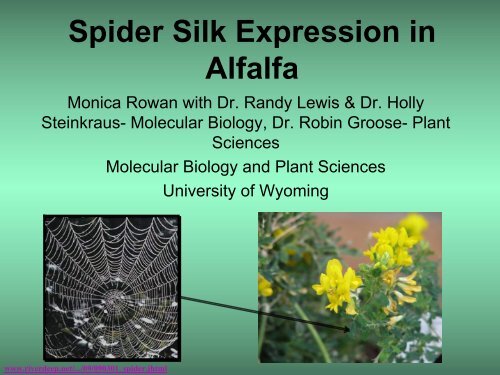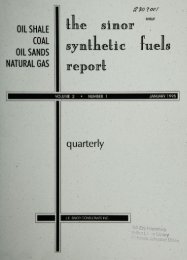Spider Silk Expression in Alfalfa
Spider Silk Expression in Alfalfa
Spider Silk Expression in Alfalfa
Create successful ePaper yourself
Turn your PDF publications into a flip-book with our unique Google optimized e-Paper software.
<strong>Spider</strong> <strong>Silk</strong> <strong>Expression</strong> <strong>in</strong><br />
<strong>Alfalfa</strong><br />
Monica Rowan with Dr. Randy Lewis & Dr. Holly<br />
Ste<strong>in</strong>kraus- Molecular Biology, Dr. Rob<strong>in</strong> Groose- Plant<br />
Sciences<br />
Molecular Biology and Plant Sciences<br />
University of Wyom<strong>in</strong>g<br />
www.riverdeep.net/.../09/090301_spider.jhtml
<strong>Silk</strong> <strong>in</strong> spiders
Why <strong>Spider</strong> <strong>Silk</strong>?<br />
Comparisons of Mechanical<br />
Properties of <strong>Spider</strong> <strong>Silk</strong><br />
Material Strength (Nm -2) Elasticity (%) Energy to Break (Jkg -1)<br />
Dragl<strong>in</strong>e <strong>Silk</strong> 4 x 10^9 35 4 x 10^5<br />
KEVLAR 4 x 10^9 5 3 x 10^4<br />
Rubber 1 x 10^6 600 8 x 10^4<br />
Tendon 1 x 10^9 5 5 x 10^3__________<br />
• Data derived from Gosl<strong>in</strong>e, J.M.; Dennv, M.W.; Demont, M.E. Nature 1984,<br />
309,551
What can silk be used for?<br />
‣ New textiles<br />
‣ Improved shield<strong>in</strong>g material that<br />
could take the place of Kevlar <strong>in</strong><br />
bulletproof vests.<br />
‣ Composite materials for build<strong>in</strong>g and<br />
aerospace applications<br />
‣ F<strong>in</strong>e sutures, artificial tendons and<br />
ligaments
Why Plant <strong>Expression</strong>?<br />
‣Low cost (10-50 fold<br />
less than <strong>in</strong> E. coli).<br />
‣Easy to scale up.<br />
‣Agricultural<br />
advances provide<br />
for rapid harvest<strong>in</strong>g<br />
and process<strong>in</strong>g.<br />
http://www.wapa.gov/es/pubs/esb/1999/99Oct/at_cl<strong>in</strong>ton.htm
Plant <strong>Expression</strong> of <strong>Silk</strong><br />
• Genetic Eng<strong>in</strong>eer<strong>in</strong>g of<br />
plants is well<br />
established<br />
• Adaptation as largescale<br />
bioreactors for<br />
commercially valuable<br />
molecules<br />
• Production of spider<br />
silk has been h<strong>in</strong>dered<br />
because of lack of a<br />
suitable large scale<br />
production system<br />
Tobacco<br />
Arabidopsis<br />
Potato<br />
<strong>Alfalfa</strong>
<strong>Alfalfa</strong> (Medicago sativa L.)<br />
‣ Perennial crop,<br />
adaptable<br />
‣ Open to transformation<br />
‣ High prote<strong>in</strong> content<br />
- Up to 24% of dry weight<br />
is prote<strong>in</strong><br />
- If expressed at 1-2% of<br />
TSP, yield of 218 kg of<br />
silk prote<strong>in</strong>/acre/year<br />
- 2.5–12g/kg leaf tissue<br />
‣ High MW prote<strong>in</strong>s<br />
http://www.ars.usda.gov/images/docs/3172_3356/<strong>Alfalfa</strong>%20Flower.jpg
Comparison of various expression systems<br />
for the production of recomb<strong>in</strong>ant silk prote<strong>in</strong><br />
under optimized conditions.<br />
<strong>Expression</strong><br />
System<br />
Prote<strong>in</strong><br />
Concentration<br />
Total Prote<strong>in</strong><br />
Yield<br />
Production<br />
Time<br />
Bacteria 100mg/L; 30,000L<br />
fermentor<br />
3kg/run<br />
2-4 months<br />
Goats<br />
15g/L; 8L/day; with<br />
a lactation of 150 d<br />
18kg/goat/year<br />
1-2 years<br />
<strong>Alfalfa</strong><br />
1% of total soluble<br />
prote<strong>in</strong>, 10T/acre<br />
assum<strong>in</strong>g 5<br />
cutt<strong>in</strong>gs/year<br />
218kg/acre/year<br />
4-5 years
Project Objectives<br />
1) Insert a synthetic gene for<br />
spider silk <strong>in</strong>to the alfalfa<br />
genome.<br />
2) Analyze resultant plants to<br />
determ<strong>in</strong>e gene copy number<br />
and prote<strong>in</strong> expression level.<br />
3) Design an effective protocol<br />
to purify spider silk prote<strong>in</strong>s<br />
from alfalfa.<br />
4) Cross plants express<strong>in</strong>g silk<br />
with a Wyom<strong>in</strong>g adapted<br />
cultivar.
Orig<strong>in</strong>al silk constructs<br />
‣Synthetic constructs based on N. clavipes sequence.<br />
‣E. coli codon bias<br />
‣MaSp 1 -> 16 repeats of 99 bp, each encod<strong>in</strong>g:<br />
GGAGQGGYGGLGSQGAGRGGLGGQGAGAAAAAA<br />
GGX = 3 10 helix = elasticity (GA)n/(A)n = beta sheet = strength
Transformation of alfalfa<br />
Selective + hormones: formation of calli<br />
‣ A. tumefaciens: LBA4404<br />
‣ <strong>Alfalfa</strong>: Regen S27<br />
‣Transformed ~120 leaves/clone<br />
‣Explants moved to soil: 30/clone<br />
•kan<br />
•ticar<br />
•k<strong>in</strong>et<strong>in</strong><br />
•2,4-D<br />
Selective – hormones: encourages root and shoot development
Parent Generation<br />
‣MaSp1 + C #7 X WisFal<br />
‣Analysis of F1 progeny<br />
– Southern (DNA level)<br />
– Western (Prote<strong>in</strong> level)
F1 Southern Blot analysis<br />
‣Digested alfalfa genomic DNA with the restriction enzyme NdeI.<br />
‣Hybridized with a radioactively-labeled homologous probe.<br />
‣ Exam<strong>in</strong>ed images for the presence of a 2.3kb-hybridiz<strong>in</strong>g fragment,<br />
which <strong>in</strong>dicated the silk gene was <strong>in</strong>corporated <strong>in</strong>to the plant genome.
Extraction of TSP’s from<br />
MaSp1+C-transformed alfalfa<br />
‣ Ground leaves <strong>in</strong> liquid<br />
N 2<br />
‣ Prepared crude extract<br />
‣ Heat-treated soluble<br />
extract; 90 o C, 10’<br />
‣ Pelleted precipitated<br />
prote<strong>in</strong>s<br />
‣ Exam<strong>in</strong>ed by SDS-<br />
PAGE
Western Blot Analyses<br />
MW<br />
G1<br />
G3<br />
B3<br />
O1<br />
WT<br />
M4 (+)<br />
75<br />
50<br />
61kD <strong>Spider</strong> <strong>Silk</strong><br />
Prote<strong>in</strong> Band<br />
AB α M 4 (MaSp1)
Summary of Southern/Western<br />
results<br />
‣105 F1 plants analyzed<br />
- 74 positive on DNA level<br />
- 4 positive on the prote<strong>in</strong> expression<br />
level<br />
‣Consequently only 4% of the F1 plants<br />
tested are express<strong>in</strong>g the silk prote<strong>in</strong>.
WHY such low numbers?<br />
‣Gene Silenc<strong>in</strong>g<br />
– Multiple transgene copies<br />
– Methylation of promoter region<br />
‣Prote<strong>in</strong> <strong>in</strong>stability….prote<strong>in</strong> itself<br />
– No subcellular target<strong>in</strong>g
Improvements<br />
‣ Change codon usage (<strong>in</strong>crease yield):<br />
- orig<strong>in</strong>al constructs -> E. coli codon bias<br />
- designed new constructs -> alfalfa codon bias<br />
‣ Change vector (ER retention signal):<br />
- orig<strong>in</strong>al constructs -> pIBT110<br />
- use new vector -> pCB301-KDEL
New b<strong>in</strong>ary vector<br />
‣ pCB301-kan-CaMv-leb4sig-100xELP-cmyc-KDEL<br />
100xELP<br />
100xELP<br />
(VPGXX) 100<br />
KDEL<br />
LB<br />
nptIII (kanR)<br />
cmyc tag<br />
legum<strong>in</strong><br />
signal peptide<br />
Met<br />
CaMv 35S<br />
promoter<br />
DraIII<br />
BamHI<br />
XbaI<br />
pCB301-kan 100 ELP<br />
8359 bp<br />
neo (kanR)<br />
RB
Future Work<br />
‣Collaboration with Medicago (Canada)<br />
- New vectors<br />
‣Transient Assay Development<br />
‣Transformed leaves with new constructs<br />
and analyze resultant plants.
Acknowledgements<br />
Randy Lewis, Ph.D.<br />
Holly Ste<strong>in</strong>kraus, Ph.D.<br />
Rob<strong>in</strong> Groose, Ph.D.<br />
Entire Lewis Lab<br />
NSF EPSCoR for the opportunity
Questions?















![pace SrntfletIc fne]its report - Alliance Digital Repository](https://img.yumpu.com/10493335/1/190x245/pace-srntfletic-fneits-report-alliance-digital-repository.jpg?quality=85)
